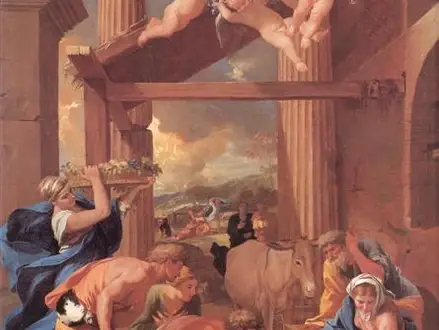Title of Artwork: “Adoration of the Shepherds”

Artwork by Nicolas Poussin
Year Created 1633-1934
Summary of Adoration of the Shepherds
Portrait of the Adoration of the Shepherds by Nicolas Poussin (1594–1665) is a painting that now hangs in London’s National Gallery (Room 19). A work of art, it’s an oil painting on canvas that measures 97.2 by 74 centimetres (with uneven edges). The lower right stone is signed “N. Pusin.fe” [“fecit”]. This is unusual for Poussin. Cardinal Gian Carlo de’ Medici, the second son of Grand Duke Cosimo II of Tuscany, purchased the painting in 1637 and had it installed in his villa outside Florence.
To date, it belongs to a group of paintings with a “coppery” colour scheme, which is the primary source of its identification. Classical elements have been incorporated into the standard figures.
All About Adoration of the Shepherds
There are at least 20 painted and seven printed copies of the painting dating back to the 17th and 18th centuries, respectively. These early sketches appear to show Poussin’s thoughts about the painting, but some may not be his or may have been drawn before the painting was finished. The painting contains a number of references to other artists, including Raphael, as is typical of Poussin.
A woman holding a large wicker tray full of fruit, five putti, the Annunciation to the Shepherds in the distance, and a woman with a basket of fruit complete the cast of the Nativity of Jesus in art. As the scene unfolds, it takes place in an old but decaying classical building, with a crude wooden lean-to stable added to it. An unusually “coppery” colour scheme is created by the golden stone of the building, which is echoed by the tanned bodies of the shepherds and other elements such as the cloudy sky. The blue of Mary’s mantle and the red of her fruit are prominent colours as well. In the distance, Joseph’s right-hand ox almost disappears into the wall.
The figures in the small background scene of the Annunciation to the Shepherds, in contrast to the still central scene, are extremely agitated, with extreme and strenuous poses. Just above the topmost vine leaves in the basket is a loosely painted white angel. The foreground figures have a frozen sculptural quality like other Poussin figures from this period. The female figure in the green dress is clearly visible. A painting of the Nativity by Raphael appears to have inspired the first kneeling shepherd (Vatican Loggie).
Poussin’s paintings from the period between 1633 and 1634 share a common colour scheme. An illustration of Dresden’s Gemäldegalerie Alte Meister’s 1633 Adoration of the Magi shows that the London Adoration of the Shepherds was painted later than that date. Now that a drawing with a preparatory sketch on the verso has been found in the Royal Collection, it has been determined that this painting was completed by 1633–35, and that the Louvre’s Saving of the Infant Pyrrhus was completed by 1634 at the latest. During his time as French ambassador to Rome, between June 1633 and July 1634, this was made for Marshal Charles III de Créquy.
Information Citations
En.wikipedia.org, https://en.wikipedia.org/.






















